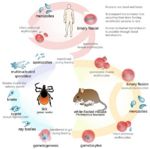[[Category:]]
- Infects a wide range of host species in different areas of the world
Babesiosis has severe effects on cattle production in parts of the world. First of all, it prevents European breeds from being successful in tropical regions where ticks are endemic as well as occurring sporadically in the UK and Ireland causing losses of around £8 million per year.
Life Cycle
- Both trans-stadial and trans-ovarian transmission occurs
- Each female tick produces 3000 eggs
- The tick is the definitive host
- Babesia multiplies in the red blood cells by budding
- Forms 2-4 daughter cells (species dependent)
- Giemsa blood smears can differentiate between species using 'Difquik' stain
- Babesia species are either small or large depending on the size of the daughter cells
- Small Babesia
- E.g. B. divergens
- E.g. B. gibsoni
- Peripheral nucleus
- Obtuse angle
- Large Babesia
- E.g. B. major
- E.g. B. canis-complex
- Central nucleus
- Acute angle
- Daughter cells disrupt the red blood cell and are released
- Spread and infect other red blood cells
- Antigen is released which adsorbs onto other red blood cells
- Causes haemolysis and haemoglobin pigmentation
- Causes haemolytic anaemia, haemoglobinuria and fever
Enzootic Instability
- Low rate of transmission
- Few infected ticks
- Infrequent exposure
- Immunity wanes or is completely absent in many individuals
- Low levels of herd immunity
- Higher incidence of disease
Enzootic Stability
- High rate of transmission
- Many infected ticks
- Frequent exposure boosts immunity
- High level of herd immunity
- Lower incidence of disease
- Babesia bovis myositis
- In cattle
- Infrequent muscle necrosis

